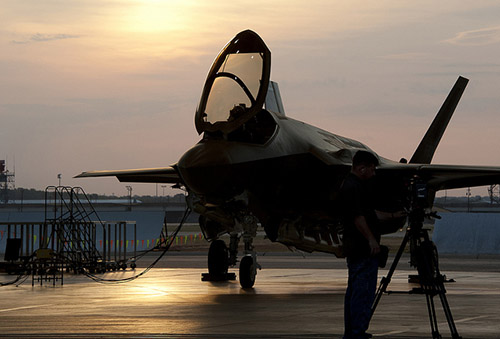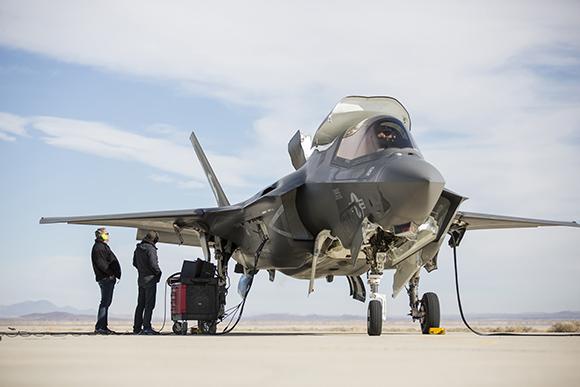A "glitch" (software anomaly caused by an unpredictable error) interferes with the F-81 radar's AN / APG-35 AESA capacity. It is considered the main threat to achieve the Initial Operational Capacity (IOC) of the Lightning II with the Air Force, estimated between August 1st and 31 next December.
This is a problem of stability - declared General Jeffrey Harrigian, director of the F-35 Integration Office at the Pentagon - which forces us to restart the system. We detected the anomaly in Block 3i last December, while we were testing. Lockheed Martin would have already discovered the main cause of the unpredictable error and tests would be in progress to verify the stability of the new software. The new code - added Harrigian - must be delivered to the USAF by the end of March, otherwise we risk delays that could seriously shift the entry into service with the Aviation.
Considering that the error is not cyclical, the final solution could be transferred to the 3F. We know that the Block 3i software was delivered for flight tests last May, in support of the Air Force IOC statement. The writing of the code for the definitive development of the software (Block 3F) was completed in the 2015 and the software was delivered for in-flight tests. Throughout the 2016 further updates are expected until the completion of the 3F scheduled by the end of the phase System Development and Demonstration Program (SDD) in autumn 2017, in support of the US Navy's IOC declaration scheduled for 2018 and the launch of the IOT & E (Initial Operational Test and Evaluation) phase. As of December 31, the program had completed 80% of the expected test points in the development and demonstration phase (SDD) and was in line with the expected completion in the fourth quarter of 2017.
To temporarily resolve the anomaly, Lockheed Martin could resort to "temporary" software, the same used by the development and operational assessment team to test the codes. We know the Joint Program Office confirmed four months of "potential delay" for the 3F, but confirms the operational functionality by the autumn of the same year.
The flight tests with the Block 3F started last January 15. The tests are necessary to detect any conflicts between the main systems and to make any corrections. The 3F software should provide full war capabilities. The 3i Block had been called the Pentagon's main concern. The Department of Defense for the operational evaluation of the systems did not hesitate to call it a disaster.
The main problems with ALIS remain. THE'Autonomic Logistics Information System o 'ALIS' is the nerve center of the F-35 system. Intent, it should allow pilots as well as ground supportive force to take proactive actions to ensure the efficiency of the fighter in any operational theater. The version of 'ALIS' delivered to the Marines is the 2.0.1. This version implements all the improvements made to date in the framework of an incremental development approach. Improved and increased real-time aircraft maintenance capacity, as well as mission planning and debriefing. The missions are loaded on a hard disk. Once on the net, 'ALIS' monitors the hunt and suggests to the ground staff the necessary maintenance before and after the mission. For the Department of Defense for the operational evaluation of the systems, ALIS complains about "multiple critical issues and a complex architecture with probable and largely untested IT deficiencies". The Block 1A / 1B includes the 78 per cent of the source code necessary for the Initial Operative Capacity of the F-35 by providing the software for training and primary interaction between the various main systems.
 The fleet has currently "loaded" the Block-2A software. Increases the aircraft's overall capabilities for pilot training including functionality off board fusion, initial data links, electronic countermeasures and improved debrief. With the block-2A, the 86 per cent of the code necessary to reach the is provided Initial Operational Capacity. The Marine Corps with the F-35B has reached the Initial Operational Capacity with the 2B software block. The 2B provides basic Close Air Support with the possibility of launching AMRAAM (Advanced Medium Range Air to Air Missile), JDAM (Joint Direct Attack Munition) and GBU-12 (laser-guided aerial bomb). It should be noted that the F-35B in service with the Marines is equipped with a special version of the Block 2B software. The Marine squadron, called '1 Group', presents most of the hardware changes already implemented (and which will be integrated into mass production) such as reinforced bulkheads. The aircraft could go into battle with 'reduced' equipment: AIM-120 AMRAAM missiles, GBU-12 bombs and GBU-39. The F-35 of the Marines have the equipment of weapons necessary to conduct Close Air Support, air interdiction and a limited ability to conduct enemy suppression / destruction missions.
The fleet has currently "loaded" the Block-2A software. Increases the aircraft's overall capabilities for pilot training including functionality off board fusion, initial data links, electronic countermeasures and improved debrief. With the block-2A, the 86 per cent of the code necessary to reach the is provided Initial Operational Capacity. The Marine Corps with the F-35B has reached the Initial Operational Capacity with the 2B software block. The 2B provides basic Close Air Support with the possibility of launching AMRAAM (Advanced Medium Range Air to Air Missile), JDAM (Joint Direct Attack Munition) and GBU-12 (laser-guided aerial bomb). It should be noted that the F-35B in service with the Marines is equipped with a special version of the Block 2B software. The Marine squadron, called '1 Group', presents most of the hardware changes already implemented (and which will be integrated into mass production) such as reinforced bulkheads. The aircraft could go into battle with 'reduced' equipment: AIM-120 AMRAAM missiles, GBU-12 bombs and GBU-39. The F-35 of the Marines have the equipment of weapons necessary to conduct Close Air Support, air interdiction and a limited ability to conduct enemy suppression / destruction missions.
The Air Force plans to reach the Initial Operational Capacity with the F-35A in the 2016 with the next iteration of the software, called 3i. Described as a technical update of the Block-2B, the 3i will allow the aircraft to use JDAM, GBU-12 and AMRAAM. The F-35A will have substantial close air support capabilities only in the 2018, when it reaches the Full Operational Capability. Only in the 2019 (except for sensational delays), the F-35A can fire with the internal cannon and release a series of ammunition including AIM-9X, AMRAAM, GBU-12, GBU-31 and SDB-II (Small Diameter Bomb II).
The Block 3F software will provide the 100 per cent of the 'Warfighting' capabilities of the fighter, with total integration of all external systems. The SDB-II system will be integrated with the Block-4a software. The 4 Block will be divided into two segments. The Block-4a will be ready between the 2021 and the 2022, while the 4B for the 2023. The twelve million dollars to write the Block-4 have been included in the 2014 budget. Much of the development of the Block-4 will be devoted to countermeasures against existing enemy air defense systems and those that will arise in future years.
According to the provisions of the Marine Corps Aviation Plan, the F-35 will replace the entire EA-6B fleet Prowler within the 2019 and will displace the AV-8B Harrier from the 2026. Finally, the F-35 will detect the F / A-18 Hornet in the 2030. The Air Force will reach the Initial Operational Capacity of the F-35A as soon as the first squad consisting of 12-24 aircraft was formed, with trained airmen and crews able to carry out close air support missions, interdiction and limited suppression and destruction of enemy anti-aircraft defenses. The F-35A will reach the Initial Operational Capacity between August and December of the 2016. Finally, the US Navy, equipped with the F-35Cs, will reach its initial operational capacity as soon as the first squadron of 10 aircraft will be formed, with personnel and pilots of the navy trained and able to carry out the assigned missions. The F-35C will reach the initial operational capacity between August 2018 and February 2019. the complete 3F software package.
(photo: Lockheed Martin)












